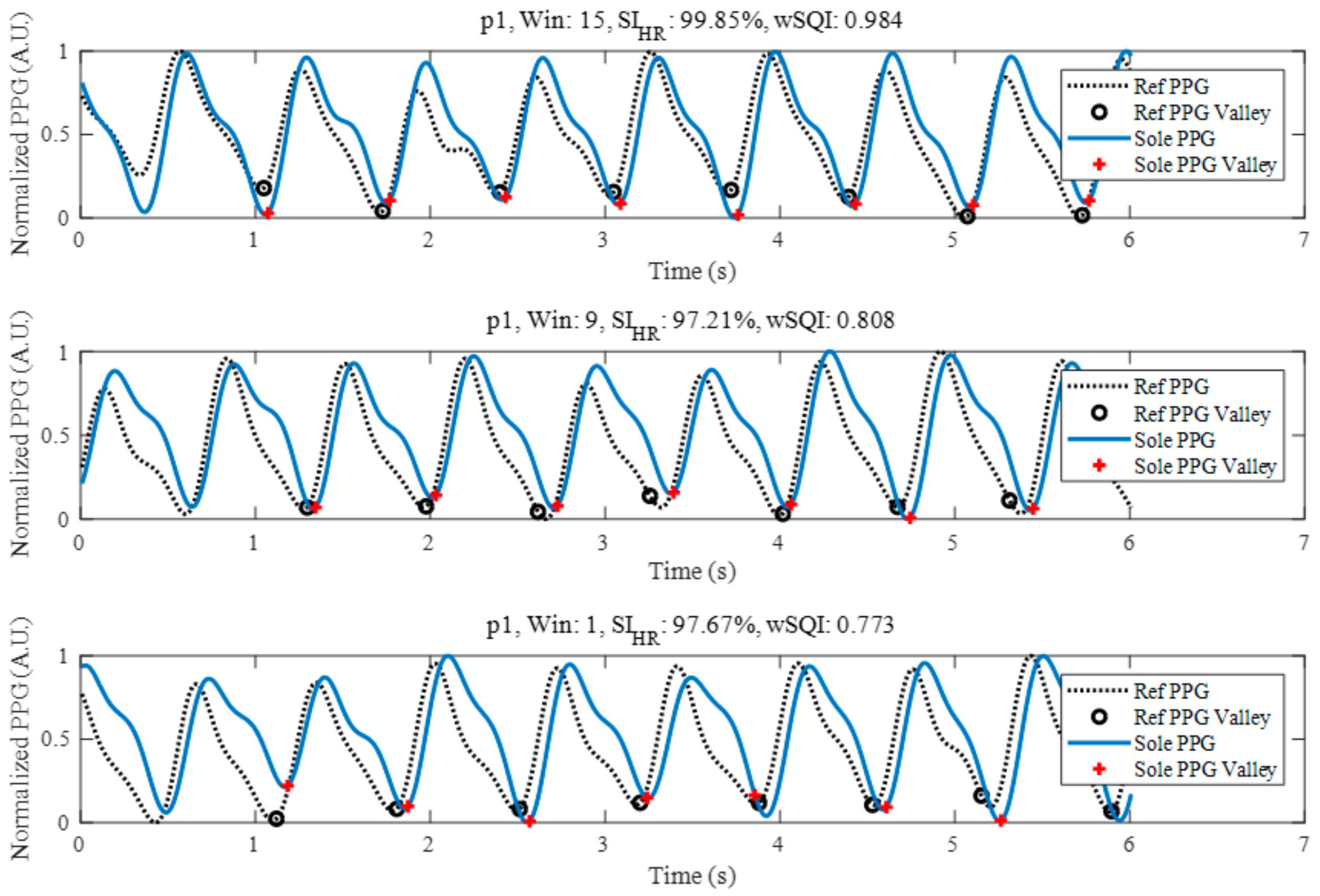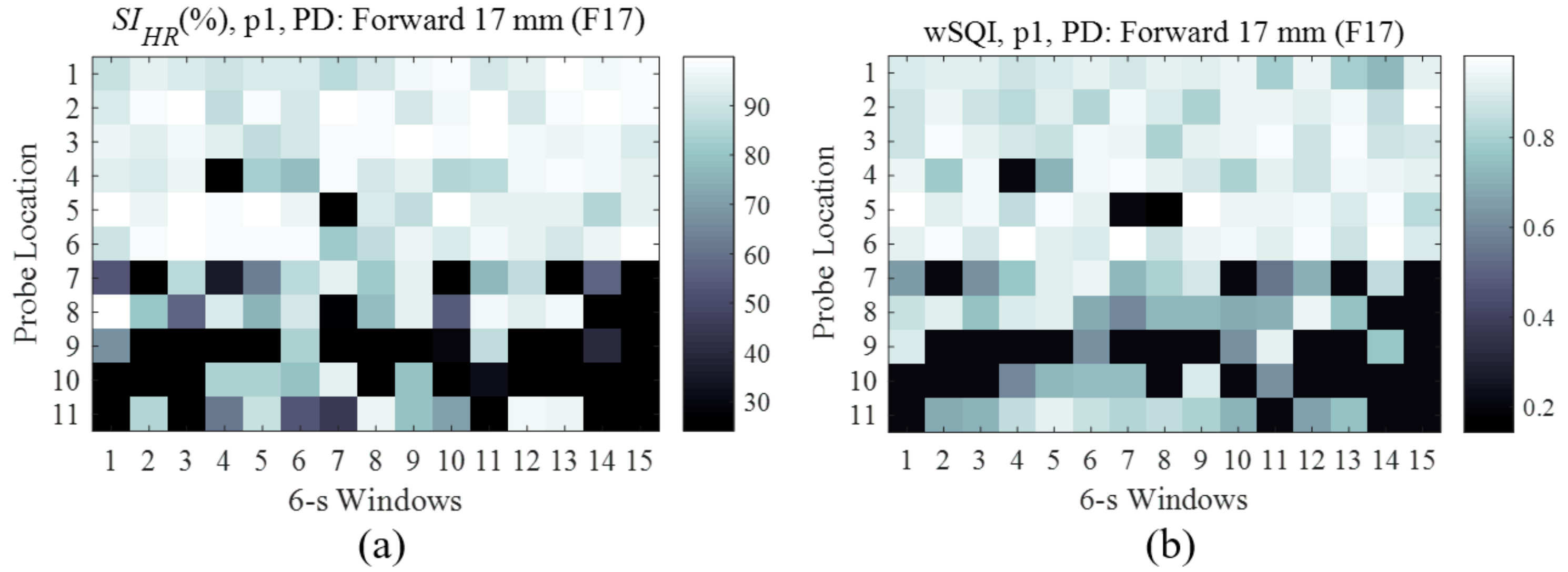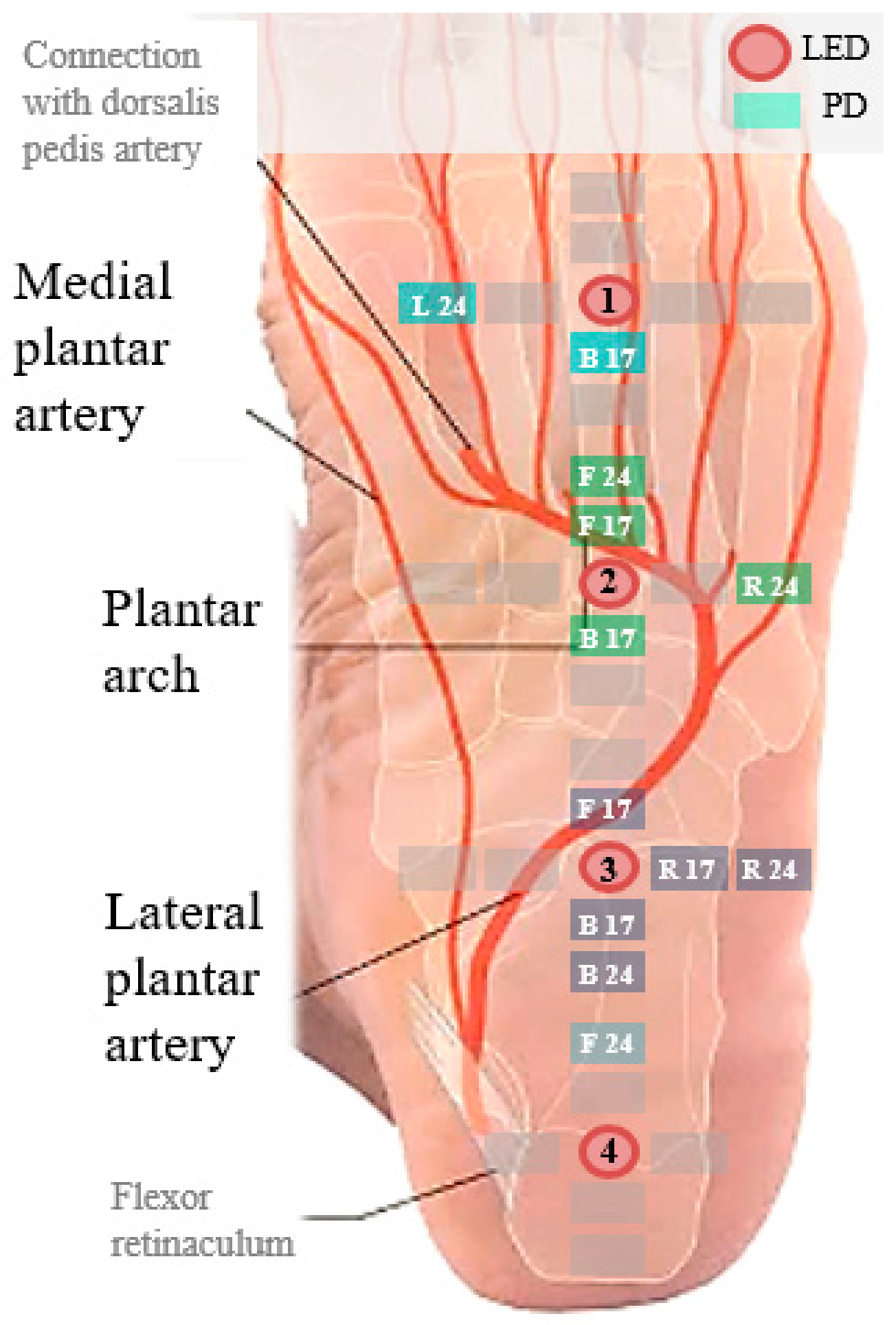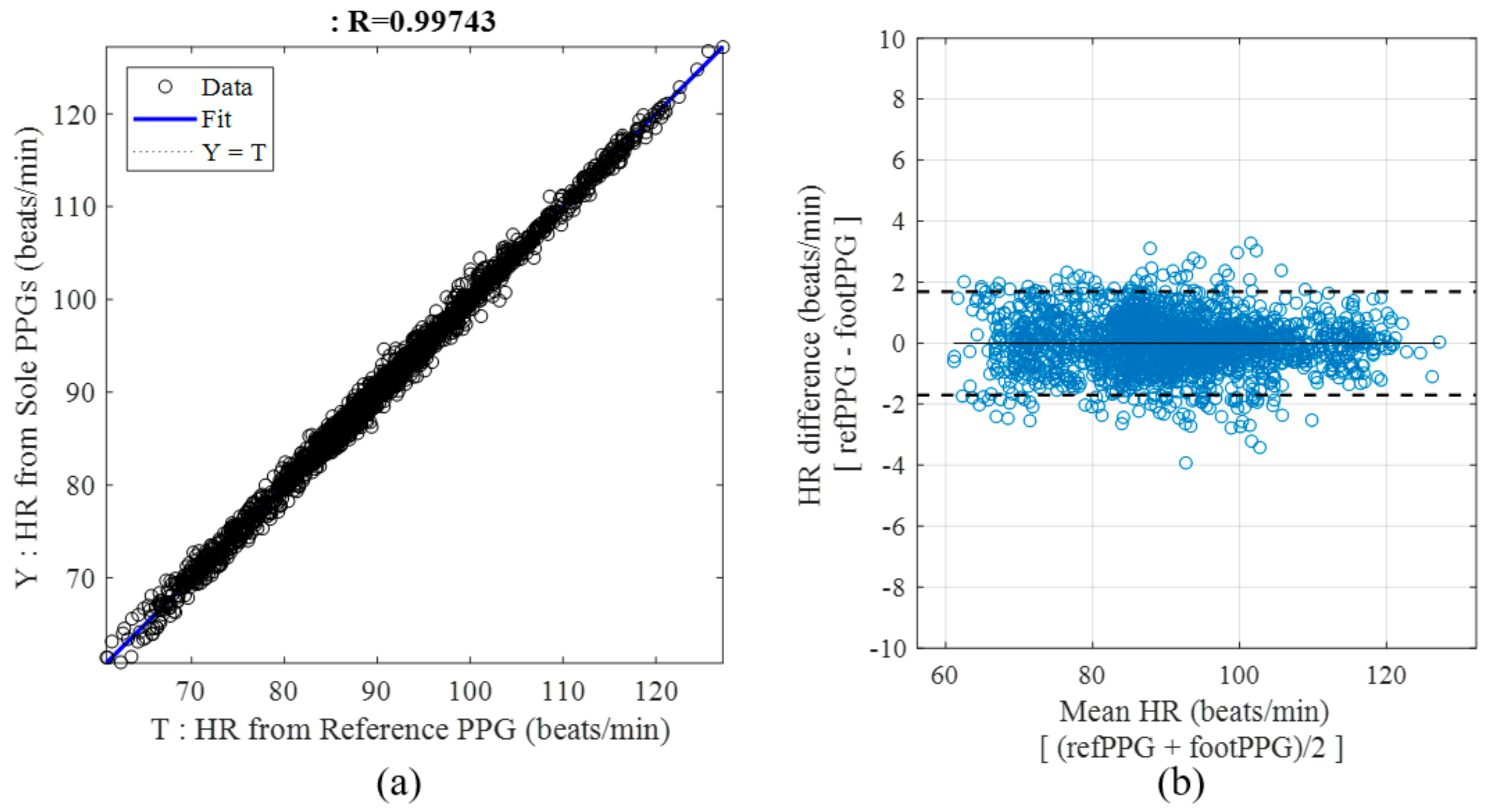Unobtrusive Photoplethysmographic Monitoring Under the Foot Sole while in a Standing Posture
Abstract
:1. Introduction
2. Materials and Methods
2.1. Foot PPG Measurements
2.1.1. Experiment 1: Foot PPG with Direct Skin-Sensor Contact
2.1.2. Experiment 2: Foot PPG with a Gap between the Skin and Embedded Sensors
2.2. PPG Valley Detection
2.3. Similarity of Estimated HR to Reference HR
2.4. Quantification of PPG Quality
2.5. Specification of a Foot PPG System and Processing Time
3. Results and Discussion
3.1. Experiment 1
3.2. Experiment 2
3.2.1. Performance Based on Optimal LED-PD Pair Selections
3.2.2. Effect of Standing Time, Age and Sex on Performance
3.3. Comparison with Unobtrusive Physiological Measurement Studies
4. Conclusions
Author Contributions
Funding
Conflicts of Interest
References
- Cobb, J.; Claremont, D. Noninvasive measurement techniques for monitoring of microvascular function in the diabetic foot. Int. J. Low Extrem. Wounds 2002, 1, 161–169. [Google Scholar] [CrossRef] [PubMed]
- Li, C.-M.; Du, Y.-C.; Wu, J.-X.; Lin, C.-H.; Ho, Y.-R.; Chen, T. Dynamic analysis with a fractional-order chaotic system for estimation of peripheral arterial disease in diabetic foot. Meas. Sci. Technol. 2013, 24, 085701. [Google Scholar] [CrossRef]
- Park, S.Y.; Baek, H.J.; Park, K.S.; Kim, Y.C. Photoplethysmographic signals to predict the success of lumbar sympathetic blockade for lower extremity pain. J. Int. Med. Res. 2014, 42, 938–948. [Google Scholar] [CrossRef] [PubMed] [Green Version]
- Nitzan, M.; Khanokh, B.; Slovik, Y. The difference in pulse transit time to the toe and finger measured by photoplethysmography. Physiol. Meas. 2002, 23, 85–93. [Google Scholar] [CrossRef] [PubMed]
- Martin, S.L.O.; Carek, A.M.; Kim, C.S.; Ashouri, H.; Inan, O.T.; Hahn, J.O.; Mukkamala, R. Weighing Scale-Based Pulse Transit Time is a Superior Marker of Blood Pressure than Conventional Pulse Arrival Time. Sci. Rep. 2016, 6, 1–8. [Google Scholar] [CrossRef] [PubMed]
- Babchenko, A.; Davidson, E.; Adler, D.; Ginosar, Y.; Kurz, V.; Nitzan, M. Increase in pulse transit time to the foot after epidural anaesthesia treatment. Med. Biol. Eng. Comput. 2000, 38, 674–679. [Google Scholar] [CrossRef] [PubMed]
- Ginosar, Y.; Weiniger, C.F.; Meroz, Y.; Kurz, V.; Bdolah-Abram, T.; Babchenko, A.; Nitzan, M.; Davidson, E.M. Pulse oximeter perfusion index as an early indicator of sympathectomy after epidural anesthesia. Acta Anaesthesiol. Scand. 2009, 53, 1018–1026. [Google Scholar] [CrossRef] [PubMed]
- Allen, J.; Murray, A. Variability of photoplethysmography peripheral pulse measurements at the ears, thumbs and toes. IEE Proc. Sci. Meas. Technol. 2000, 147, 403–407. [Google Scholar] [CrossRef]
- Allen, J.; Murray, A. Age-related changes in peripheral pulse timing characteristics at the ears, fingers and toes. J. Hum. Hypertens. 2002, 16, 711–717. [Google Scholar] [CrossRef] [PubMed] [Green Version]
- Allen, J.; Oates, C.P.; Lees, T.A.; Murray, A. Photoplethysmography detection of lower limb peripheral arterial occlusive disease: A comparison of pulse timing, amplitude and shape characteristics. Physiol. Meas. 2005, 26, 811–821. [Google Scholar] [CrossRef] [PubMed]
- Allen, J.; Overbeck, K.; Stansby, G.; Murray, A. Photoplethysmography assessments in cardiovascular disease. Meas. Control 2006, 39, 80–83. [Google Scholar] [CrossRef]
- Shin, J.H.; Lee, K.M.; Park, K.S. Non-constrained monitoring of systolic blood pressure on a weighing scale. Physiol. Meas. 2009, 30, 679–693. [Google Scholar] [CrossRef] [PubMed]
- Loram, I.D.; Lakie, M. Direct measurement of human ankle stiffness during quiet standing: The intrinsic mechanical stiffness is insufficient for stability. J. Physiol. 2002, 545, 1041–1053. [Google Scholar] [CrossRef] [PubMed]
- Kato, Y.; Nambu, M.; Imura, M.; Kuroda, Y.; Oshiro, O. Smart sensing of cardiovascular physiological information from soles without direct skin contact. In Proceedings of the 2012 Annual International Conference of the IEEE Engineering in Medicine and Biology Society, San Diego, CA, USA, 28 August–1 September 2012; pp. 5806–5809. [Google Scholar] [CrossRef]
- Zong, W.; Heldt, T.; Moody, G.B.; Mark, R.G. An open-source algorithm to detect onset of arterial blood pressure pulses. In Proceedings of the Computers in Cardiology, Thessaloniki Chalkidiki, Greece, 21–24 September 2003; pp. 259–262. [Google Scholar]
- Bland, J.M.; Altman, D.G. Measuring agreement in method comparison studies. Stat. Methods Med. Res. 1999, 8, 135–160. [Google Scholar] [CrossRef] [PubMed]
- Li, Q.; Clifford, G.D. Dynamic time warping and machine learning for signal quality assessment of pulsatile signals. Physiol. Meas. 2012, 33, 1491–1501. [Google Scholar] [CrossRef] [PubMed]
- Koski, A.; Juhola, M. Segmentation of digital signals based on estimated compression ratio. IEEE Trans. Biomed. Eng. 1996, 43, 928–938. [Google Scholar] [CrossRef] [PubMed]
- Keogh, E.; Ratanamahatana, C.A. Exact indexing of dynamic time warping. Knowl. Inf. Syst. 2005, 7, 358–386. [Google Scholar] [CrossRef] [Green Version]
- Zheng, Y.L.; Ding, X.R.; Poon, C.C.Y.; Lo, B.P.L.; Zhang, H.; Zhou, X.L.; Yang, G.Z.; Zhao, N.; Zhang, Y.T. Unobtrusive sensing and wearable devices for health informatics. IEEE Trans. Biomed. Eng. 2014, 61, 1538–1554. [Google Scholar] [CrossRef] [PubMed]
- Kranjec, J.; Beguš, S.; Geršak, G.; Drnovšek, J. Non-contact heart rate and heart rate variability measurements: A review. Biomed. Signal Process. Control 2014, 13, 102–112. [Google Scholar] [CrossRef]
- Hassan, M.A.; Malik, A.S.; Fofi, D.; Saad, N.; Karasfi, B.; Ali, Y.S.; Meriaudeau, F. Heart rate estimation using facial video: A review. Biomed. Signal Process. Control 2017, 38, 346–360. [Google Scholar] [CrossRef]
- Baek, H.J.; Chung, G.S.; Kim, K.K.; Kim, J.S.; Park, K.S. Photoplethysmogram measurement without direct skin-to-sensor contact using an adaptive light source intensity control. IEEE Trans. Inf. Technol. Biomed. 2009, 13, 1085–1088. [Google Scholar] [CrossRef] [PubMed]
- González-Landaeta, R.; Casas, O.; Pallàs-Areny, R. Heart rate detection from an electronic weighing scale. In Proceedings of the Annual International Conference of the IEEE Engineering in Medicine and Biology; Lyon, France, 22–26 August 2007; pp. 6282–6285. [Google Scholar]
- Díaz, D.H.; Casas, Ó.; Pallas-Areny, R. Heart rate detection from single-foot plantar bioimpedance measurements in a weighing scale. In Proceedings of the 2010 Annual International Conference of the IEEE Engineering in Medicine and Biology Society (EMBC’10), Buenos Aires, Argentina, 31 August–4 September 2010; pp. 6489–6492. [Google Scholar]
- Baek, H.J.; Chung, G.S.; Kim, K.K.; Park, K.S. A smart health monitoring chair for nonintrusive measurement of biological signals. IEEE Trans. Inf. Technol. Biomed. 2012, 16, 150–158. [Google Scholar] [CrossRef] [PubMed]
- Stahl, S.E.; An, H.-S.; Dinkel, D.M.; Noble, J.M.; Lee, J.-M. How accurate are the wrist-based heart rate monitors during walking and running activities? Are they accurate enough? BMJ Open Sport Exerc. Med. 2016, 2, e000106. [Google Scholar] [CrossRef] [PubMed] [Green Version]
- Poon, C.C.Y.; Zhang, Y.T.; Bao, S. Di A novel biometrics method to secure wireless body area sensor networks for telemedicine and M-health. IEEE Commun. Mag. 2006, 44, 73–81. [Google Scholar] [CrossRef]








| Probe Location | oSQI | rSQI | wSQI |
|---|---|---|---|
| 1 | 0.743 | 0.745 | 0.882 |
| 2 | 0.763 | 0.766 | 0.897 |
| 3 | 0.831 | 0.835 | 0.906 |
| 4 | 0.729 | 0.726 | 0.846 |
| 5 | 0.708 | 0.712 | 0.827 |
| 6 | 0.915 | 0.918 | 0.927 |
| 7 | 0.436 | 0.438 | 0.613 |
| 8 | 0.468 | 0.464 | 0.704 |
| 9 | 0.269 | 0.277 | 0.402 |
| 10 | 0.260 | 0.258 | 0.408 |
| 11 | 0.272 | 0.276 | 0.628 |
| Participant | HRerr [BPM] | wSQI | Probe Location | PD Position |
|---|---|---|---|---|
| p1 | 0.002 | 0.897 | 2 | F17 |
| p2 | 0.002 | 0.881 | 7 | F17 |
| p3 | 0.011 | 0.898 | 3 | F24 |
| p4 | 0.038 | 0.959 | 10 | B24 |
| Average | 0.013 | 0.909 |
| Probe Location | Horizontal PDs | Vertical PDs | ||||||
|---|---|---|---|---|---|---|---|---|
| L24 | L17 | R17 | R24 | F24 | F17 | B17 | B24 | |
| 1 | 92.5 | 87.5 | 88.0 | 92.0 | 92.5 | 87.4 | 91.4 | 93.8 |
| 2 | 97.9 | 86.3 | 85.7 | 97.6 | 97.5 | 85.5 | 89.4 | 90.4 |
| 3 | 93.9 | 96.8 | 85.9 | 99.1 | 98.4 | 90.0 | 93.8 | 92.6 |
| 4 | 86.6 | 90.7 | 87.1 | 96.7 | 89.0 | 90.8 | 89.7 | 88.1 |
| 5 | 89.2 | 83.6 | 92.0 | 95.8 | 92.2 | 90.9 | 80.4 | 88.2 |
| 6 | 93.6 | 84.1 | 90.6 | 94.2 | 95.3 | 91.7 | 90.4 | 91.0 |
| 7 | 94.0 | 87.1 | 85.9 | 94.8 | 94.8 | 90.4 | 92.2 | 92.9 |
| 8 | 92.3 | 92.6 | 88.7 | 94.3 | 94.4 | 95.0 | 88.2 | 90.0 |
| 9 | 88.0 | 87.5 | 79.7 | 94.3 | 93.5 | 87.3 | 83.4 | 89.1 |
| 10 | 92.3 | 92.4 | 81.5 | 94.5 | 95.6 | 88.4 | 81.6 | 92.1 |
| 11 | 92.0 | 85.4 | 82.8 | 88.6 | 93.9 | 85.4 | 83.0 | 86.9 |
| Selected Count Mean (SD) | LED | PD | HRerr Mean (SD) | SIHR [%] Mean (SD) | wSQI Mean (SD) |
|---|---|---|---|---|---|
| 7.4 (8.3) | 3 | R24 | 0.56 (0.40) | 99.4 (0.4) | 0.845 (0.065) |
| 5.9 (7.9) | 3 | B24 | 0.58 (0.41) | 99.3 (0.4) | 0.883 (0.054) |
| 3.8 (6.5) | 2 | R24 | 0.66 (0.45) | 99.2 (0.6) | 0.880 (0.068) |
| 3.8 (6.7) | 2 | F24 | 0.81 (0.34) | 99.1 (0.4) | 0.859 (0.074) |
| 2.8 (6.3) | 3 | F17 | 0.53 (0.43) | 99.3 (0.5) | 0.841 (0.076) |
| 2.0 (3.2) | 1 | B17 | 0.77 (0.47) | 99.1 (0.6) | 0.856 (0.068) |
| 2.0 (3.7) | 4 | F24 | 0.73 (0.44) | 99.1 (0.5) | 0.819 (0.075) |
| 1.0 (2.4) | 2 | F17 | 0.86 (0.45) | 99.0 (0.6) | 0.818 (0.058) |
| 1.0 (2.7) | 2 | B17 | 0.73 (0.52) | 99.2 (0.5) | 0.886 (0.050) |
| 0.9 (1.7) | 3 | B17 | 0.81 (0.65) | 99.0 (0.8) | 0.825 (0.077) |
| 0.8 (2.1) | 1 | L24 | 0.66 (0.48) | 99.2 (0.6) | 0.834 (0.079) |
| 0.8 (1.6) | 3 | R17 | 0.75 (0.48) | 99.2 (0.5) | 0.833 (0.084) |
| LED Number | Selection Ratio (%) | Sole Length (mm) Mean (SD) | Cases of Selection Ratio > 25% |
|---|---|---|---|
| 1 | 12.1 | 173 (10) | 7 |
| 2 | 28.7 | 173 (11) | 22 |
| 3 | 49.9 | 174 (12) | 36 |
| 4 | 9.3 | 181 (11) | 6 |
| Signal Quality Criteria | Standing Period | ||
|---|---|---|---|
| Windows 1~20 | Windows 21~40 | p-Value | |
| wSQI > 0.6 | 99.0% | 98.5% | 0.29 |
| wSQI > 0.7 | 94.5% | 94.1% | 0.47 |
| wSQI > 0.8 | 75.8% | 74.1% | 0.22 |
| Signal Quality Metric | Age | Sex | ||||
|---|---|---|---|---|---|---|
| ≤27 (N = 26) | >27 (N = 27) | p-Value | Men (N = 30) | Women (N = 23) | p-Value | |
| HRerr (BPM) | 0.66 (0.31) | 0.61 (0.31) | 0.66 | 0.63 (0.34) | 0.65 (0.27) | 0.66 |
| SIHR (%) | 99.2 (0.36) | 99.3 (0.38) | 0.65 | 99.3 (0.4) | 99.2 (0.33) | 0.41 |
| wSQI | 0.859 (0.04) | 0.871 (0.03) | 0.51 | 0.867 (0.04) | 0.862 (0.03) | 0.54 |
| Authors | Modality | Quality Metrics | Performance | Participants |
|---|---|---|---|---|
| González-Landaeta et al., 2008 | BCG by weighing scale in the standing posture | Absolute 95% confidence interval of IBI | 21 ms | 17 (N.A.) |
| Diaz et al., 2010 | IPG under the plantar region in the standing posture | Absolute 95% confidence interval of IBI | 30.65 ms | 10 (3 women) |
| Baek et al., 2012 | CCECG (back) PPG through clothing (thigh) BCG while leaning back on a chair | Mean HR error | 0.034 BPM (CCECG) 0.640 BPM (PPG) 1.857 BPM (BCG) | 5 men |
© 2018 by the authors. Licensee MDPI, Basel, Switzerland. This article is an open access article distributed under the terms and conditions of the Creative Commons Attribution (CC BY) license (http://creativecommons.org/licenses/by/4.0/).
Share and Cite
Hong, S.; Park, K.S. Unobtrusive Photoplethysmographic Monitoring Under the Foot Sole while in a Standing Posture. Sensors 2018, 18, 3239. https://doi.org/10.3390/s18103239
Hong S, Park KS. Unobtrusive Photoplethysmographic Monitoring Under the Foot Sole while in a Standing Posture. Sensors. 2018; 18(10):3239. https://doi.org/10.3390/s18103239
Chicago/Turabian StyleHong, Seunghyeok, and Kwang Suk Park. 2018. "Unobtrusive Photoplethysmographic Monitoring Under the Foot Sole while in a Standing Posture" Sensors 18, no. 10: 3239. https://doi.org/10.3390/s18103239







